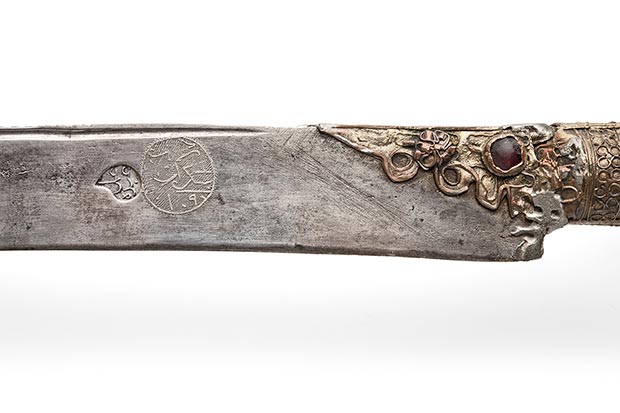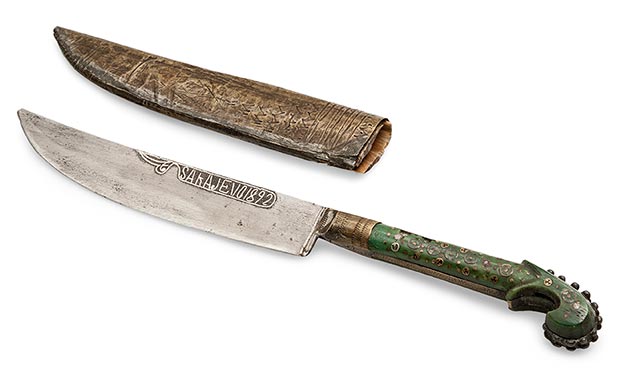
ART COLLECTIONS Weapons from the Collection of the Bosniak Institute - Adil Zulfikarpasic Foundation
Jun 22, 2018 FEATURE, Art Collection

The exhibition was opened by Amina Rizvanbegovic Dzuvic, Director of the Bosniak Institute, and the curators of the exhibition Adnan Muftarevic and Lebiba Dzeko. "The goal of the exhibition", as Amina Rizvanbegovc Dzuvic pointed out, "is to enrich the cultural and educational contents of the Bosniak Institute, and to contribute to the understanding of the collection's use value and artistic value, as well as the historical context in which the weapons emerged and were used."
_IslamicArtsMagazine.jpg) From the opening of the exhibition, L-R: Lebiba Dzeko, Amina Rizvanbegovic Dzuvic and Adnan Muftarevic / Photo © Islamic Arts Magazine
From the opening of the exhibition, L-R: Lebiba Dzeko, Amina Rizvanbegovic Dzuvic and Adnan Muftarevic / Photo © Islamic Arts Magazine
Amina Rizvanbegovic Dzuvic, Director of the Bosniak Institute said, "The collection contains valuable historical, representative and diverse specimens of all types of traditional weapons: knives, scimitars or curved daggers, swords, flintlocks and rifles, in addition to a few contemporary firearms specimens, and the tremendously rare knives produced in workshops in Foca and Sarajevo during the 18th and 19th century. Many of the specimens are distinguished by the beauty of their production, the craft qualities of the workmen who decorated the weapons with silver and golden wires, mother of pearl and coral encrustations, as well as studs masterfully integrated into the wood."
_IslamicArtsMagazine.jpg) Amina Rizvanbegovic Dzuvic addressing the visitors at the opening of the exhibition / Photo © Islamic Arts Magazine
Amina Rizvanbegovic Dzuvic addressing the visitors at the opening of the exhibition / Photo © Islamic Arts Magazine
Weapons of high quality were produced in Bosnia as Adnan Muftarevic, the co-curator of the exhibition explained, "Cold steel and firearms, primarily of the Oriental style, were manufactured in many weaponry and craft workshops across the Balkans from the XV century to the XIX century. They were introduced to the Balkans immediately after the arrival of the Ottoman Empire. Primarily out of military needs, craft workshops were emerging in city bazaars and military bases. It is noted by travelogue writers that sword bazaars existed in Sarajevo as early as 1477. It was reported that the scimitars manufactured in Foca were more renowned than those manufactured in Istanbul. When purchasing the scimitar, its quality was checked using an interesting method: it was worthy only if it could cut a thin, damp silk scarf thrown on the top of its blade."
_IslamicArtsMagazine.jpg) Adnan Muftarevic addressing the visitors at the opening of the exhibition / Photo © Islamic Arts Magazine
Adnan Muftarevic addressing the visitors at the opening of the exhibition / Photo © Islamic Arts Magazine
The weapons have played a significant role throughout history, primarily for the protection of life, property and honour, and subsequently in the conquest of new territories and the spread of states. Therefore a large number of craftsmen were engaged in the manufacture, refinement and decoration of weapons. Along with the quality of the work, the decoration was also of great significance.
Lebiba Dzeko, the co-curator of the exhibition added, "Besides high-quality manufacturing, it was important that weapons were richly ornamented, thus they were embellished with calligraphic inscriptions, inlaying with gold and silver wire, precious stones and mother of pearl. These valuable weapons were not intended for the battlefields. Elaborately crafted weapons were men's ornament and men would not attend important events without wearing them. This was the practice during the Ottoman period. To a certain extent it also continued during the Austro-Hungarian times in Bosnia and Herzegovina, especially in small towns, and it completely died out before the beginning of the World War I."
_IslamicArtsMagazine.jpg) Lebiba Dzeko addressing the visitors at the opening of the exhibition / Photo © Islamic Arts Magazine
Lebiba Dzeko addressing the visitors at the opening of the exhibition / Photo © Islamic Arts Magazine
The exhibition 'Weapons from the Collection of the Bosniak Institute - the Foundation of Adil Zulfikarpasic' presents specimens of weapons that are significant for their manufacturing and decorating, as well as for their use. Apart from the weapons created in Bosnia, the exhibition also features weapons used in different parts of the world such as the Gaucho Knife from Argentina, the Yambiya Knife from Jamaica and others. The exhibited artefacts are divided into sections: knives & daggers (Gaucho Knife, Bosnian dagger, Koummya, Khanjar, Yambiya); swords & sabres (Schiavone, Tulwar, Sabre-1861, Yathagan and Saif); and rifles & firearms (Carbine, Flintlock Pistol and Shihana Rifle).
 White Haft Scimitar (Inv. no. 259/E), Ottoman Empire. Steel, bone, copper, coral; bolster wood, linen, tin. Forging, damascening, filigree. The length of the blade is 56.5 cm, the total length is 71 cm, the width of the blade is 3.2 cm, length of the handle is 14.5 cm. From the Collection of the Bosniak Institute - Adil Zulfikarpasic Foundation / Photo courtesy of Bosniak Institute
White Haft Scimitar (Inv. no. 259/E), Ottoman Empire. Steel, bone, copper, coral; bolster wood, linen, tin. Forging, damascening, filigree. The length of the blade is 56.5 cm, the total length is 71 cm, the width of the blade is 3.2 cm, length of the handle is 14.5 cm. From the Collection of the Bosniak Institute - Adil Zulfikarpasic Foundation / Photo courtesy of Bosniak Institute
 Bosnian Knife (Inv. no. 273/E), Ottoman Empire. Steel, bone, brass, corals, silver; bolsters: wood, tin, leather; forging, damascening. The length of the blade is 13.5 cm, the width of the blade is 2.2 cm, the total length is 24 cm, length of the handle is 10.5 cm. From the Collection of the Bosniak Institute - Adil Zulfikarpasic Foundation / Photo courtesy of Bosniak Institute
Bosnian Knife (Inv. no. 273/E), Ottoman Empire. Steel, bone, brass, corals, silver; bolsters: wood, tin, leather; forging, damascening. The length of the blade is 13.5 cm, the width of the blade is 2.2 cm, the total length is 24 cm, length of the handle is 10.5 cm. From the Collection of the Bosniak Institute - Adil Zulfikarpasic Foundation / Photo courtesy of Bosniak Institute
Besides the weapons, the exhibition features warrior garments and additional equipment necessary for the use of weapons, such as the Helmet, with a broad frontal part and a bar as a nose-guard that can be moved as appropriate; the Plume, a headdress decoration worn on a fez hat or a helmet; the Ottoman Shield from the 15th century made of elephant leather; the Misdrak, a type of spear used during the Ottoman period; the Gauntlet; the Turban Saruk; the Gilet, made of heavy cloth; the Heavy Coat (Gunj); the Lammelar Armour (Toke), a type of armour and male ornament made of silver and gold; the Baggy Trousers were worn in the second half of the 19th century, etc. One of the features of the exhibition is a figure of a Bey in his warrior attire with all the weapons he would have carried. Bey is a Turkish title for chieftain, traditionally applied to the leaders or rulers of various sized areas in the Ottoman Empire.
_IslamicArtsMagazine_03a.jpg) The Bey in his warrior attire / Photo © Islamic Arts Magazine
The Bey in his warrior attire / Photo © Islamic Arts Magazine
The exhibition includes also the artefacts from the National Museum of Bosnia and Herzegovina and the Museum of Sarajevo, such as the Gun Powder Flask (Barutluk), the Gun Oil Flask (Zejtinlica), the Ramrod (Harbija); the Enamluk, a silver box for the Qur'an, the Leather Belt (Bensilah), a type of belt used to carry weapons. etc.
_IslamicArtsMagazine_01.jpg) Installation view of the exhibition / Photo © Islamic Arts Magazine
Installation view of the exhibition / Photo © Islamic Arts Magazine
_IslamicArtsMagazine_02.jpg) Installation view of the exhibition / Photo © Islamic Arts Magazine
Installation view of the exhibition / Photo © Islamic Arts Magazine
_IslamicArtsMagazine_04.jpg) A visitor at the exhibition admiring the exhibits / Photo © Islamic Arts Magazine
A visitor at the exhibition admiring the exhibits / Photo © Islamic Arts Magazine
_IslamicArtsMagazine_06.jpg) Visitora at the exhibition / Photo © Islamic Arts Magazine
Visitora at the exhibition / Photo © Islamic Arts Magazine
_IslamicArtsMagazine_05.jpg) Installation view of the exhibition / Photo © Islamic Arts Magazine
Installation view of the exhibition / Photo © Islamic Arts Magazine
_IslamicArtsMagazine_02.jpg) From the opening of the exhibition / Photo © Islamic Arts Magazine
From the opening of the exhibition / Photo © Islamic Arts Magazine
The exhibition 'Weapons from the Collection of the Bosniak Institute - Adil Zulfikarpsic Foundation' will run until September 18, 2018.
Comments
Add a comment